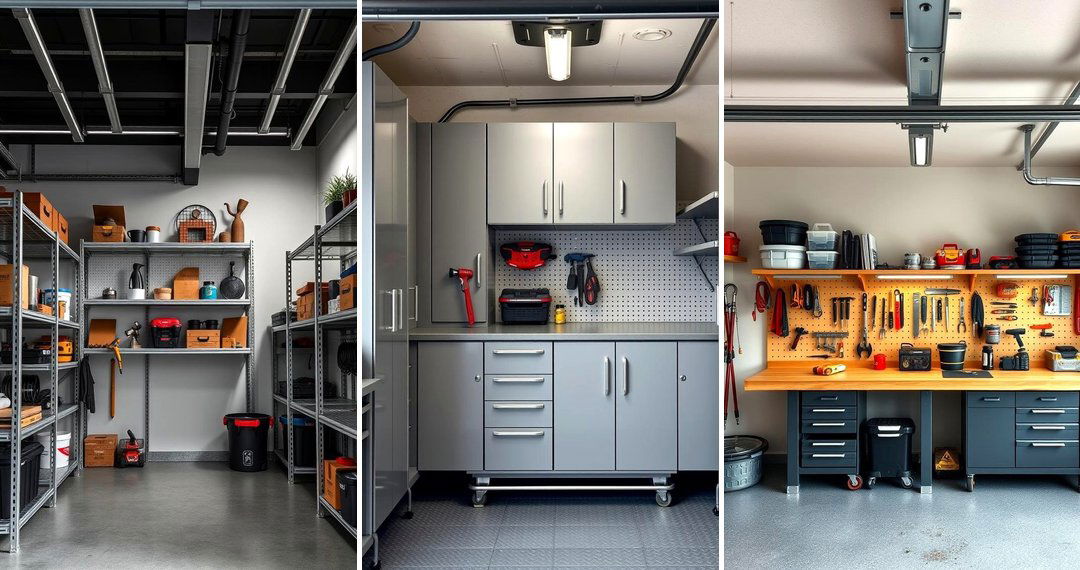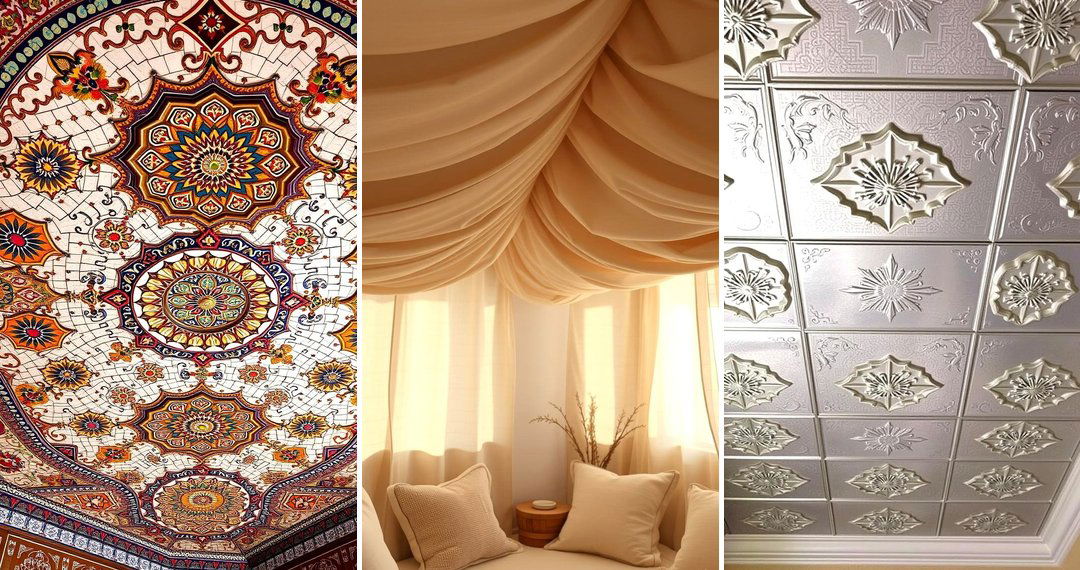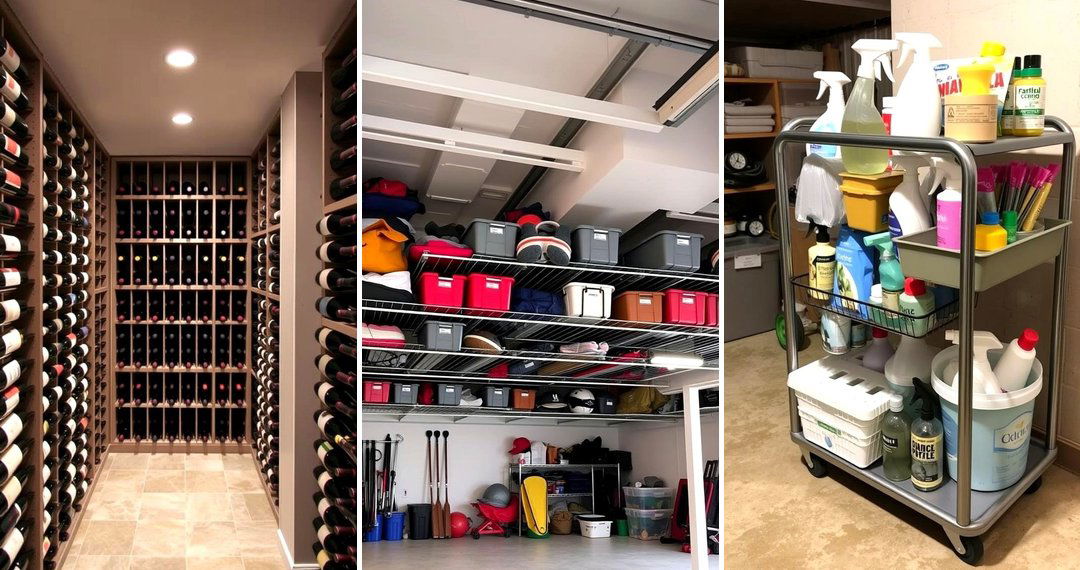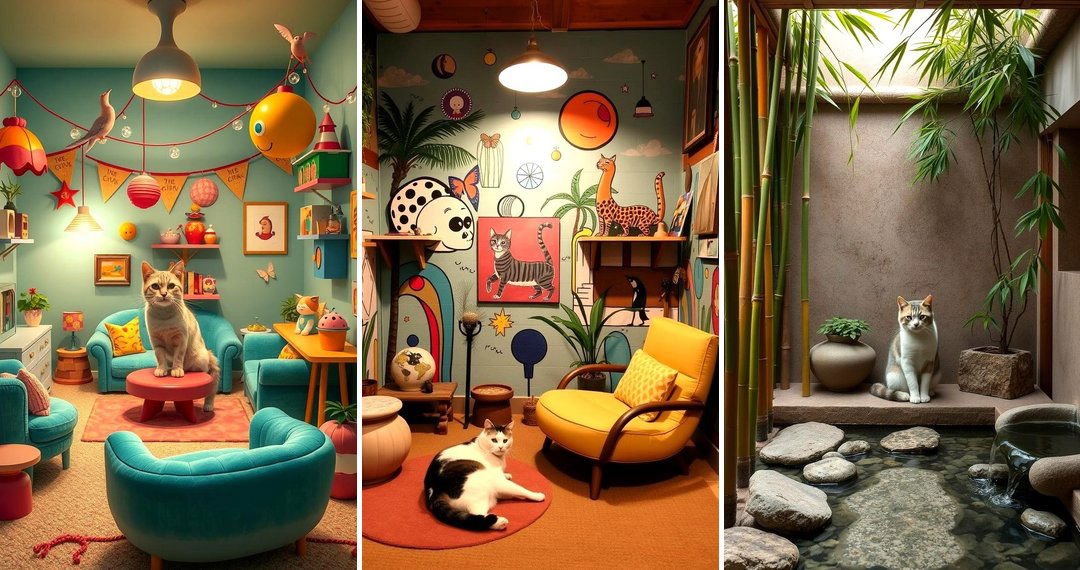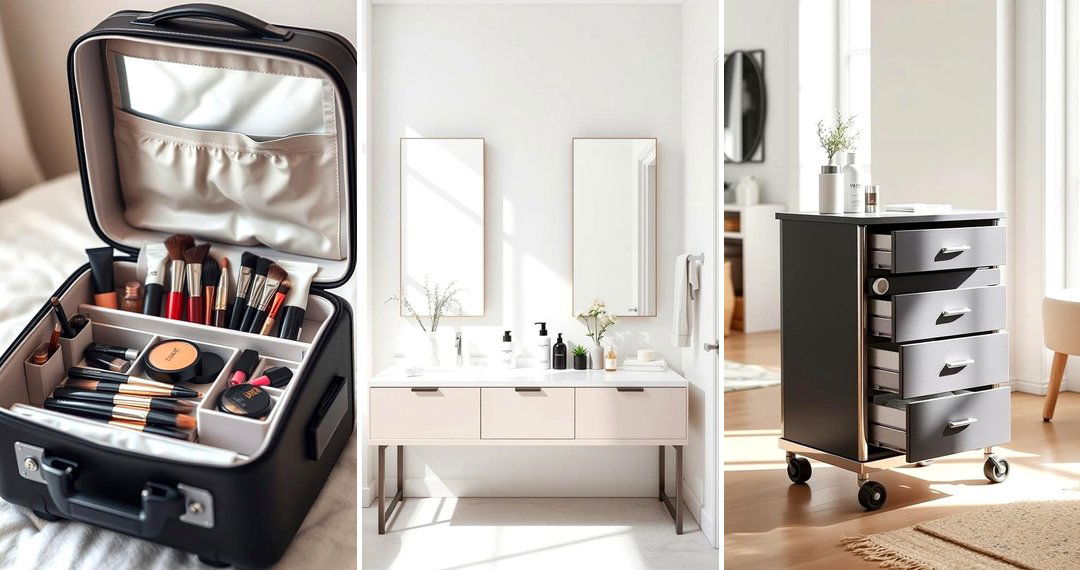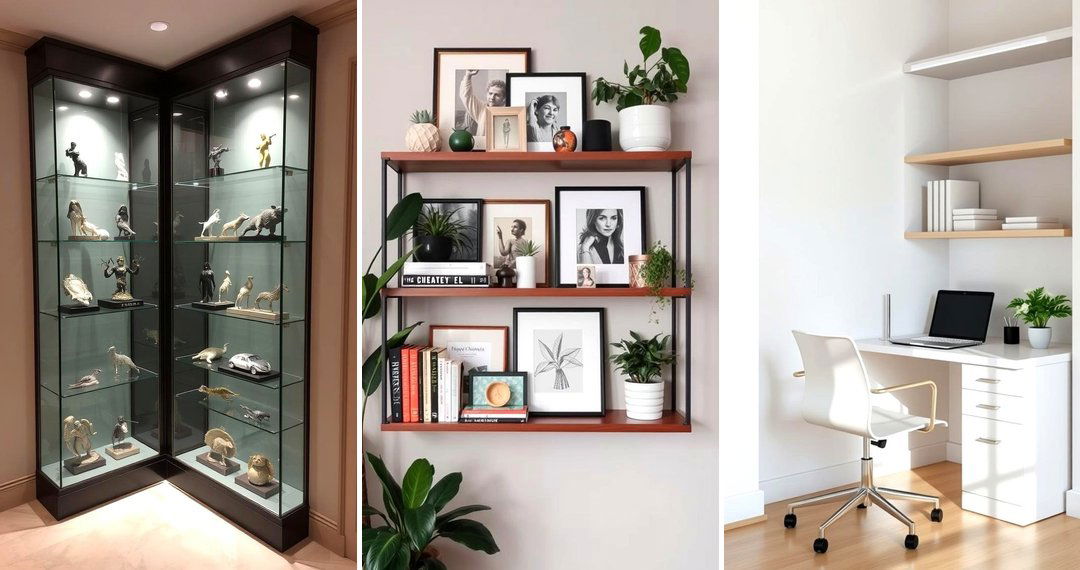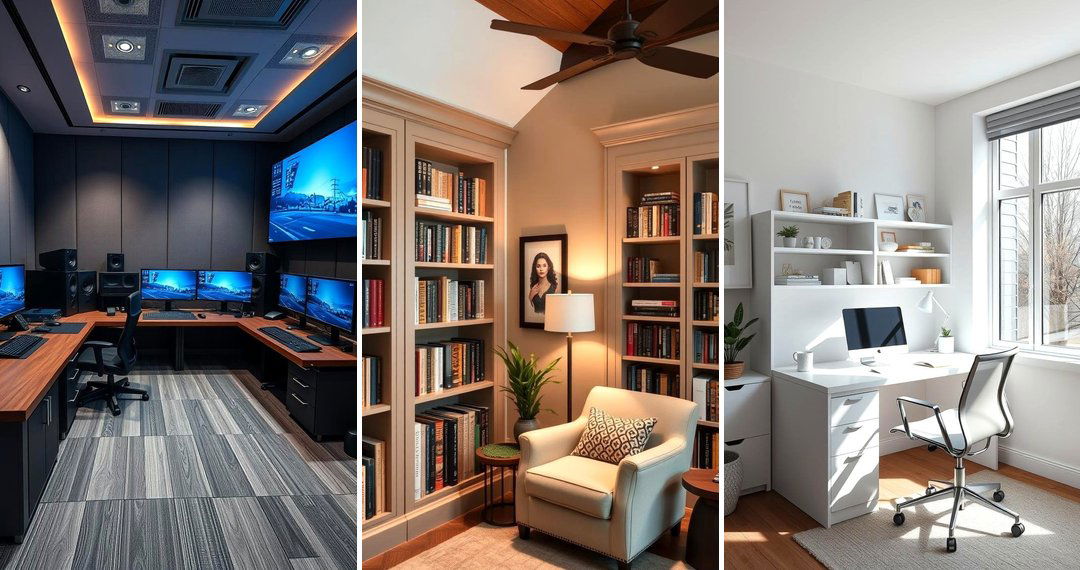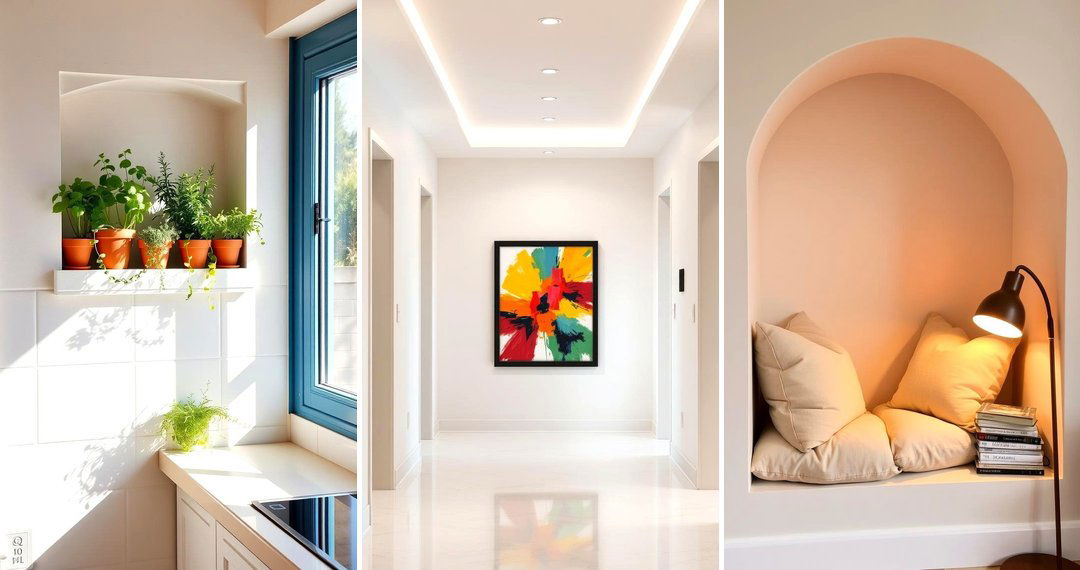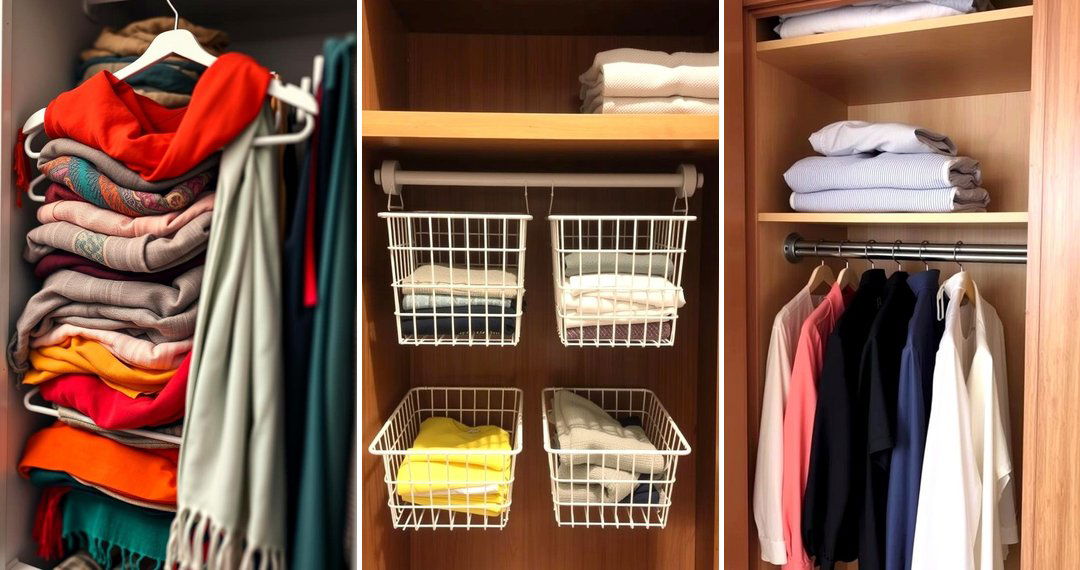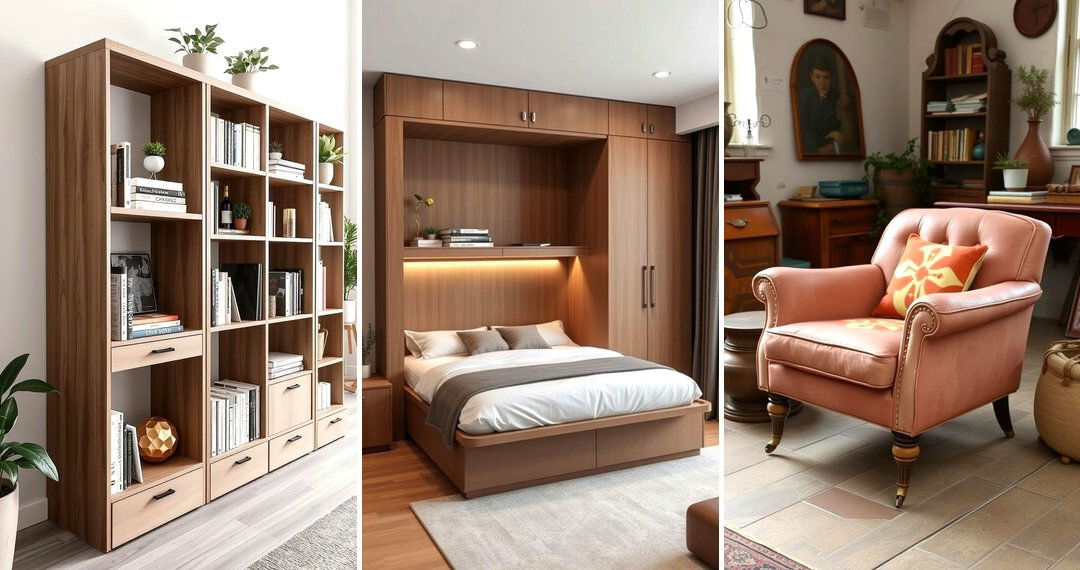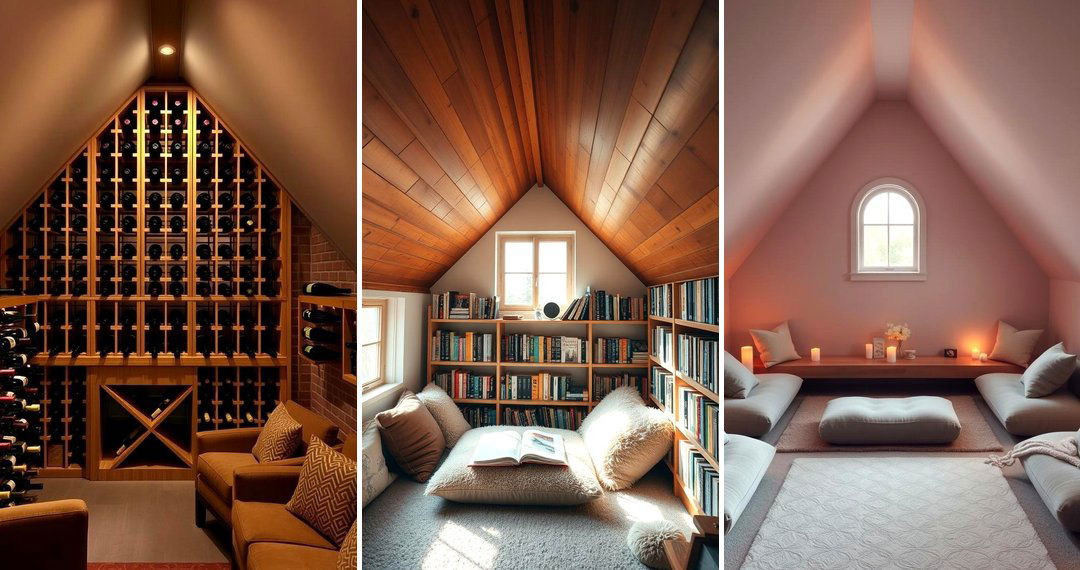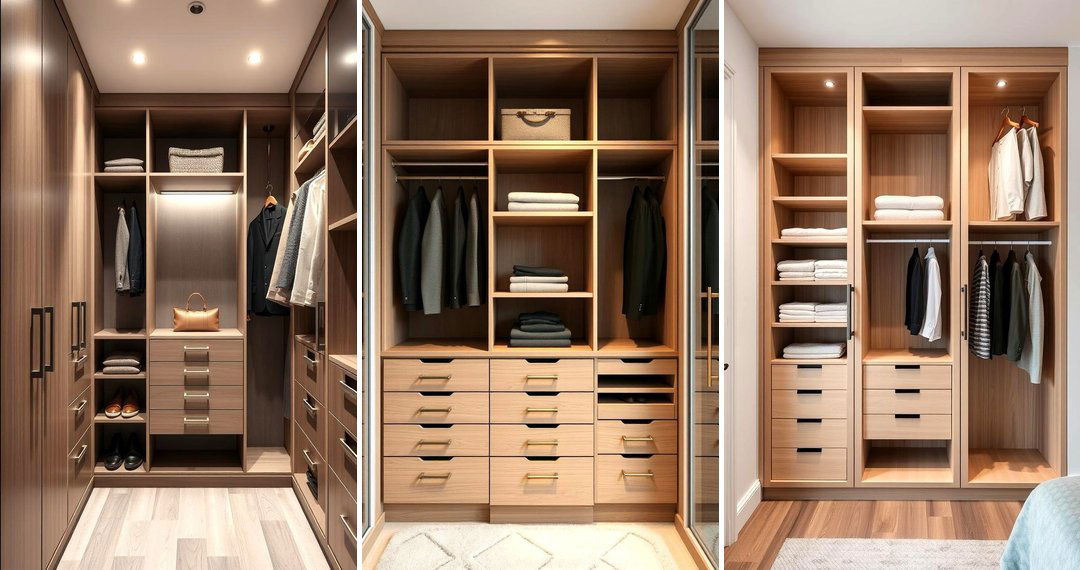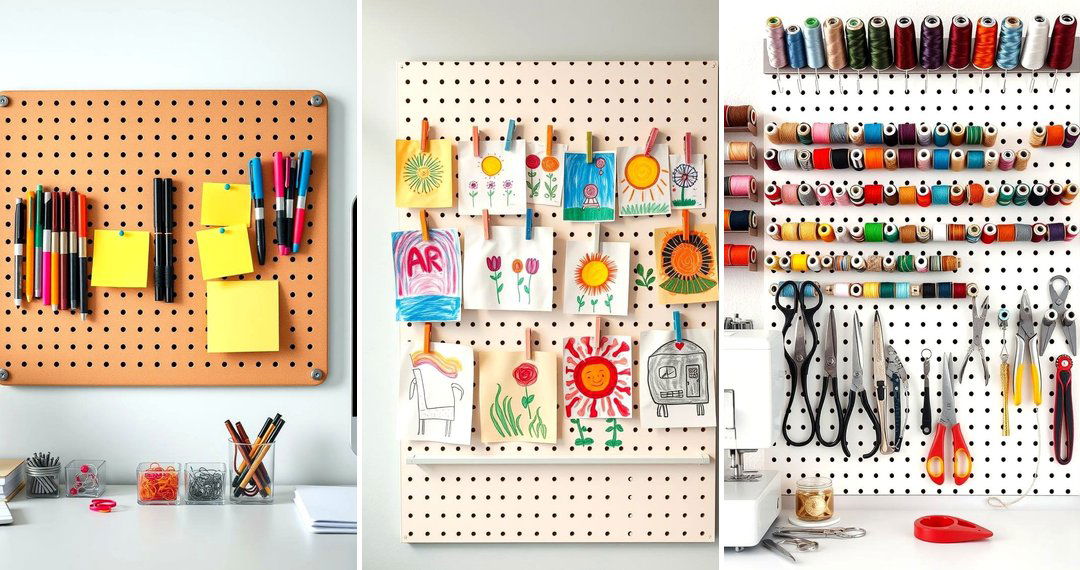Transforming your basement into a gym offers an exciting opportunity to create a space that encourages fitness and personal growth. Whether you're working with a spacious basement or a smaller area, there are endless ways to maximize the space for workouts, strength training, and recovery. Not only will this remodel enhance your home’s value, but it’ll also support your fitness journey with a customized, functional space right in the comfort of your home. From sleek designs to practical, innovative solutions, basement gyms cater to all fitness levels and styles. Let’s dive into some of the most inspiring ideas to elevate your workout routine.
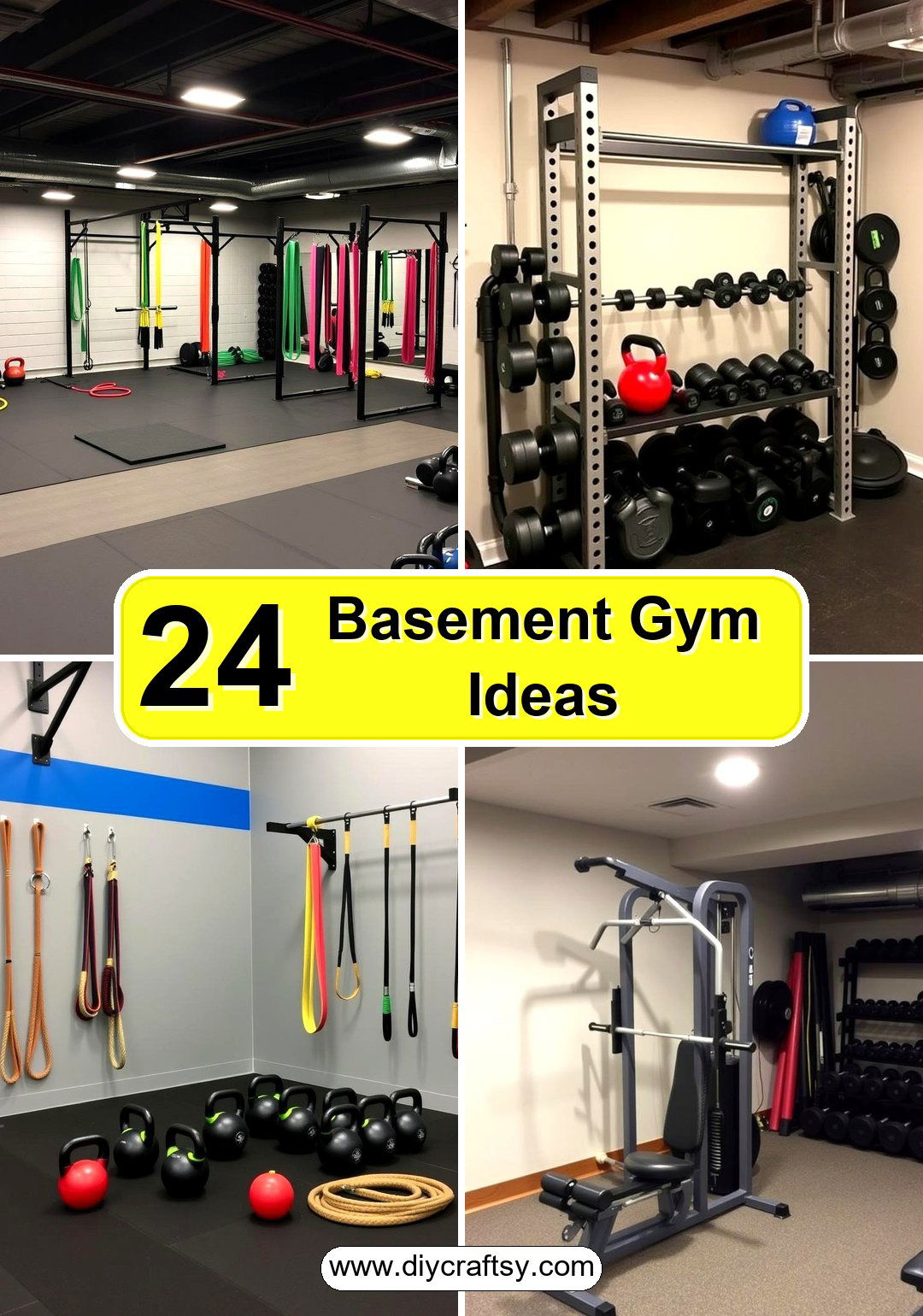
1. Home Workout Studio with Mirrors
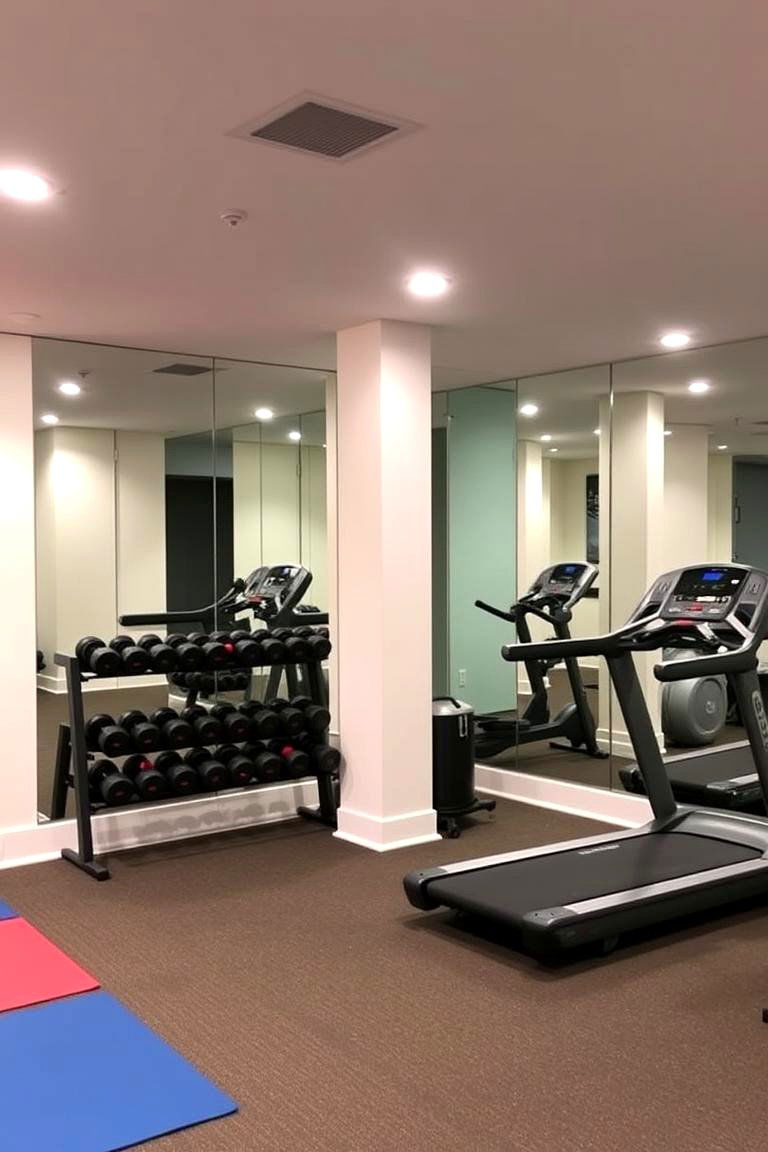
A great way to make your basement gym feel spacious is by incorporating mirrors into the design. Mirrors visually expand the room while providing an essential tool for perfecting your form. They help with posture, alignment, and technique, which is especially important for strength training and aerobic workouts. The reflective surface also adds a touch of elegance and modernity, creating an inviting atmosphere that motivates you to work out. You can place full-length mirrors on one wall to achieve this effect or use smaller sections for a more dynamic layout.
2. Industrial Style Gym
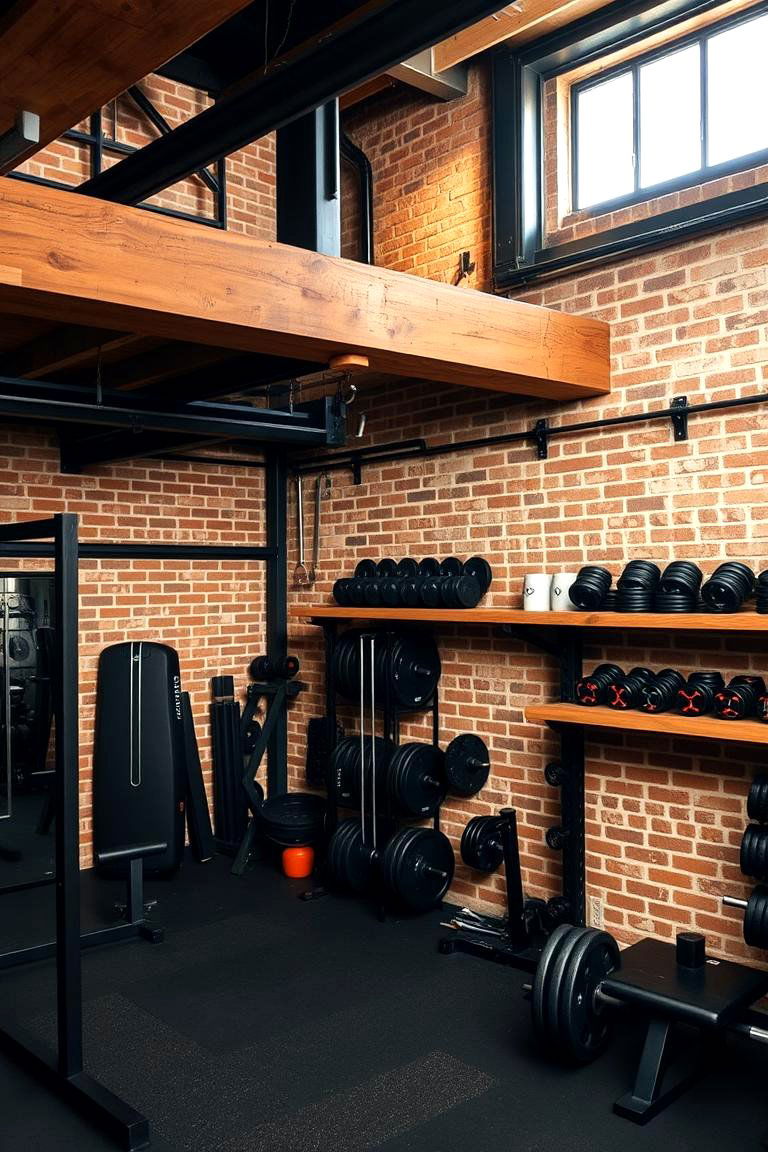
Embrace the raw charm of industrial design by leaving some of the original basement features exposed, such as brick walls, steel beams, and unfinished floors. This style is perfect for those who prefer a minimalist and no-frills gym vibe. Incorporating rugged materials, like metal shelving and wooden racks, gives the gym a masculine, strong feel. Moreover, this style often pairs well with essential gym equipment, such as kettlebells, dumbbells, and resistance bands, adding to the rugged appeal. The space feels functional, straightforward, and empowering for anyone seeking an intense workout.
3. Multi-Purpose Exercise Zone
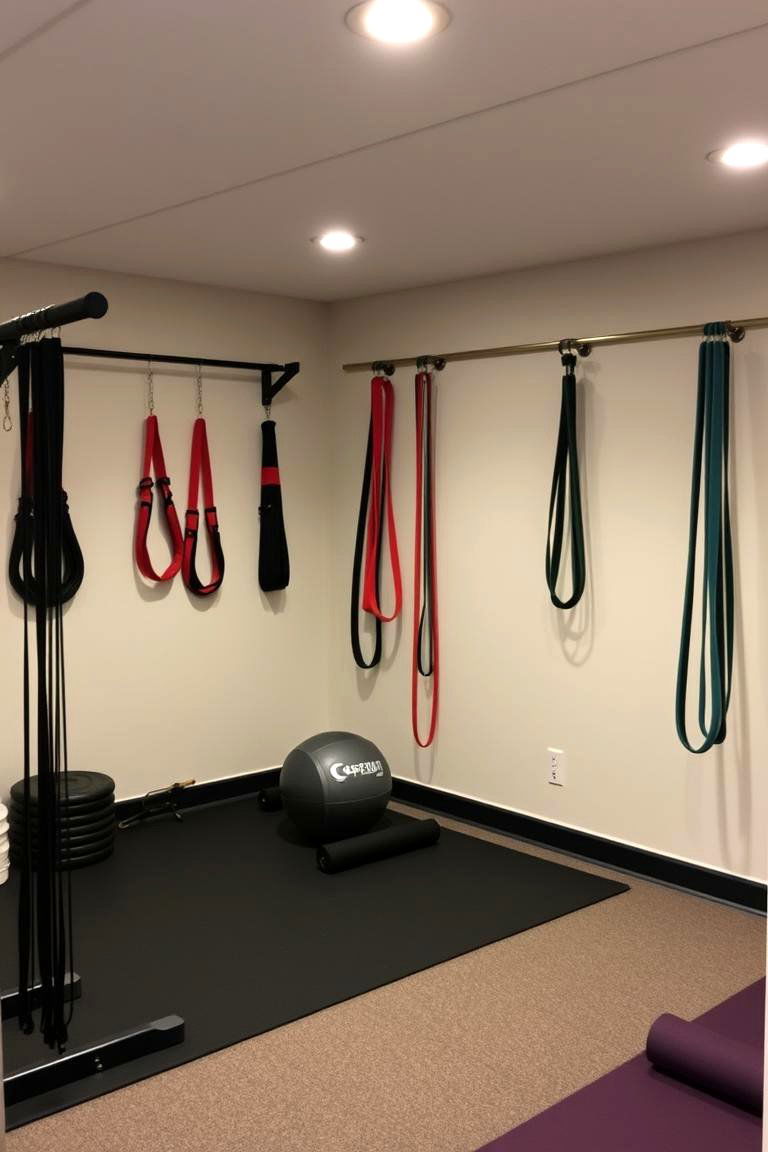
Not everyone has a large basement to work with, but that doesn’t mean you can’t have a dynamic gym. Consider creating a multi-purpose exercise zone where you can combine different types of workouts in one area. For example, you could use foldable gym equipment, such as resistance bands or a retractable rowing machine, allowing you to maximize the use of the floor space. You can dedicate one corner to yoga or stretching and another to cardio or weights. This flexible design adapts to your daily routine, ensuring the gym is used to its fullest potential.
4. Bright and Airy Basement Gym
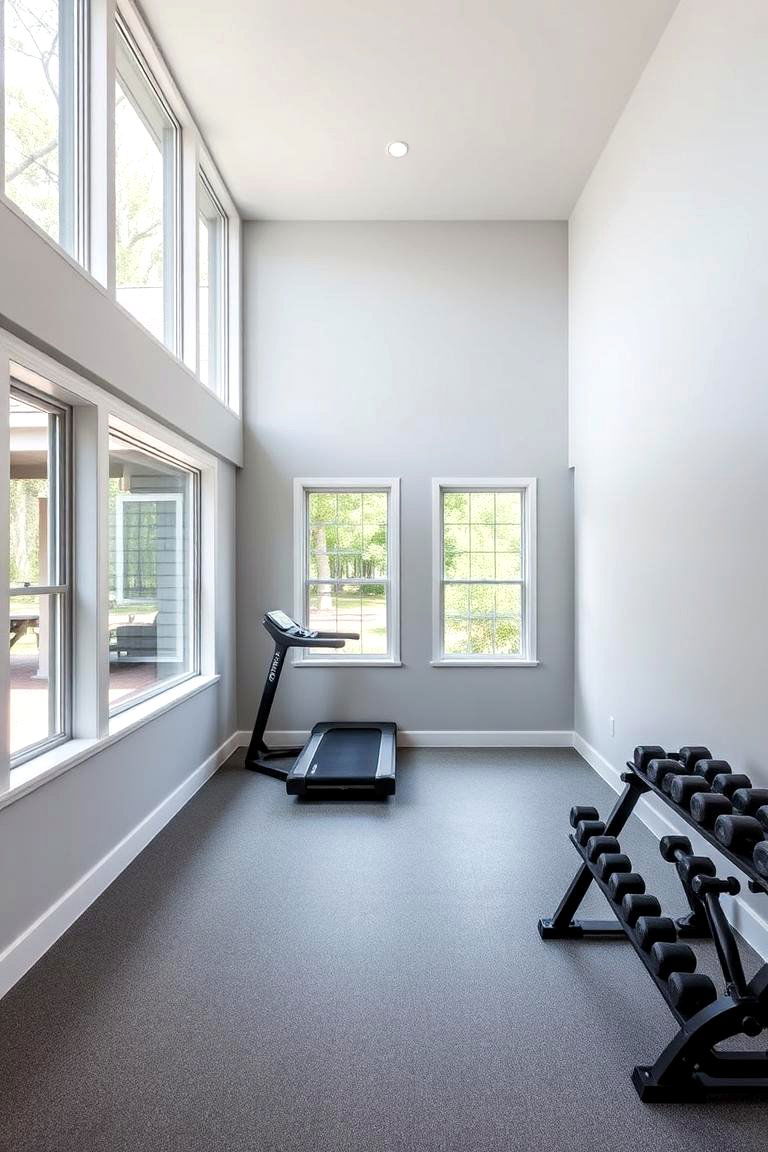
If your basement has windows or you’re willing to add some, make the most of natural light to give your gym an airy and refreshing feel. Light is essential for improving mood and energy levels, making it easier to stay motivated during a workout. Consider installing glass windows or skylights to enhance daylight exposure. Choose light-colored walls, such as white or pale grey, and keep the design minimal to avoid overwhelming the space. Bright, clean aesthetics encourage a positive, energized mindset, making your basement gym a pleasant place to sweat it out.
5. Yoga and Meditation Space
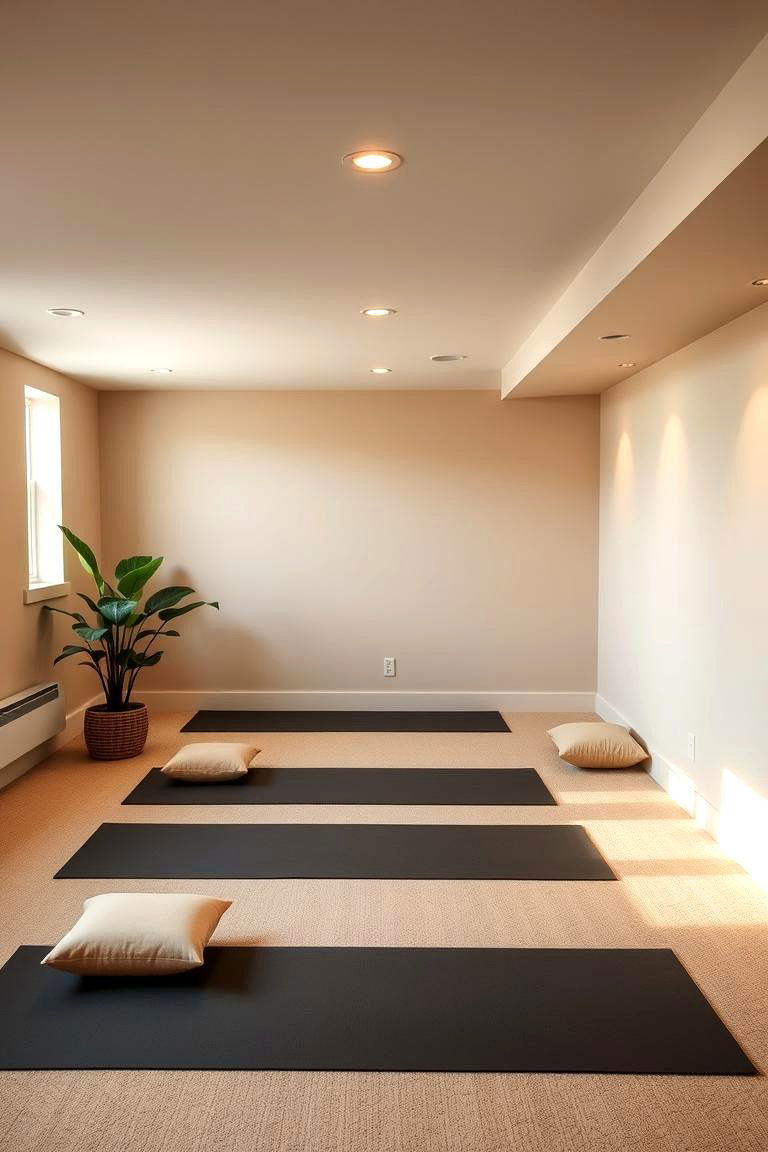
Creating a serene and calm atmosphere in your basement gym can support mindfulness practices like yoga and meditation. Use soft, neutral colors like beige or pastel tones for the walls and flooring to help promote relaxation. Incorporate a comfortable, cushioned mat, large pillows, and maybe even a small indoor plant to enhance the tranquil vibe. You can add calming elements, such as a water fountain or soft lighting, to create a peaceful environment. A space like this will allow you to unwind after intense workouts and focus on mental well-being.
6. Functional Weightlifting Area
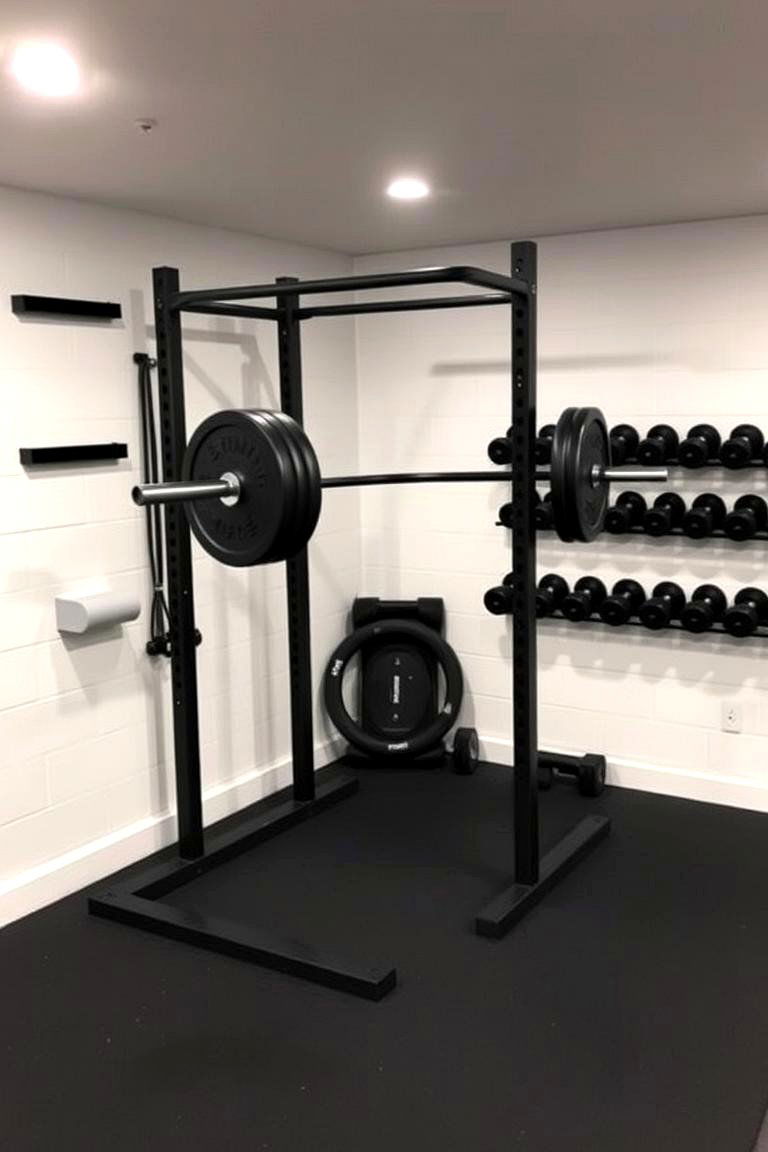
If your focus is strength training, a dedicated weightlifting space is essential. The basement can be transformed into a powerhouse for lifting with heavy-duty equipment like a squat rack, barbell, and dumbbells. For additional functionality, ensure the room has high ceilings and ample floor space to allow for a full range of motion during exercises. Consider adding rubber flooring to protect the floor and reduce noise. The key is to keep the equipment organized with racks and shelves so you can easily access everything you need during your workout sessions.
7. Cardio Workout Corner
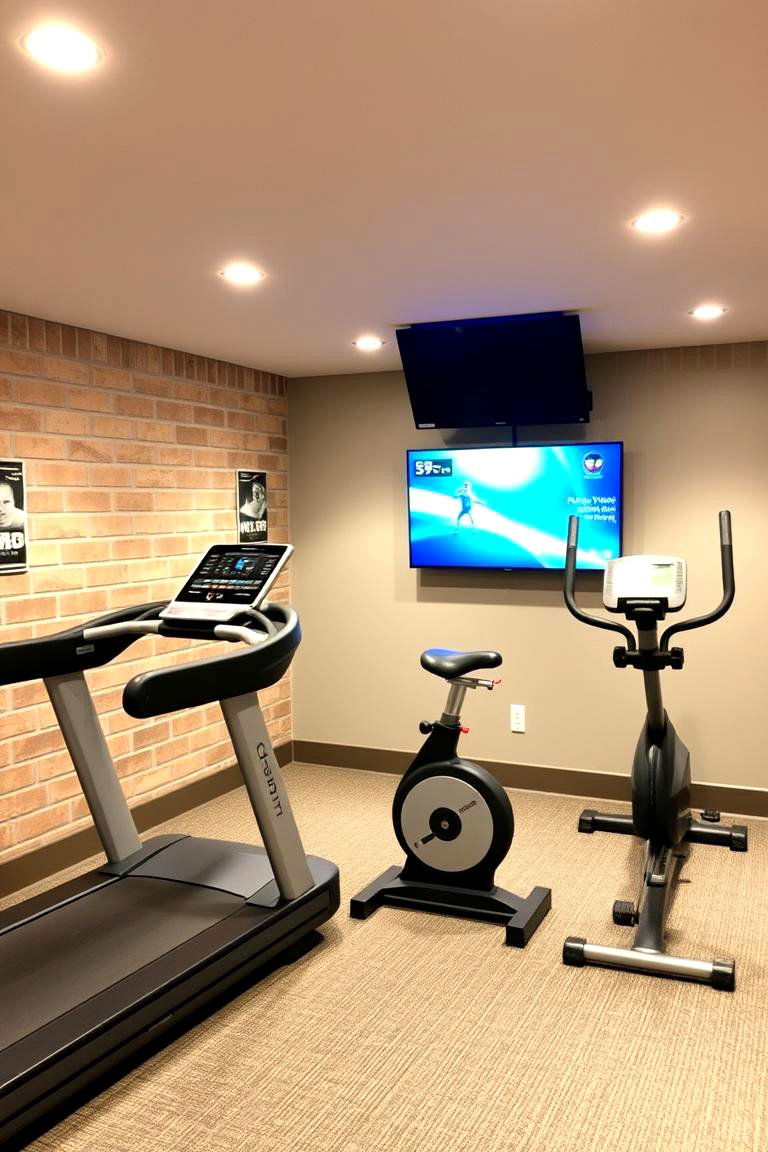
If you love cardio, turning part of your basement into a cardio-focused corner is a great idea. A treadmill, exercise bike, or elliptical machine can be placed here, along with a smart TV or speakers to keep you entertained during your workout. Make sure the area is well-ventilated and equipped with a fan or air purifier to keep the air fresh and comfortable. Organize your space efficiently, placing mats for stretching or yoga to complement the cardio equipment. This dedicated zone ensures you can perform all your cardio workouts with ease and motivation.
8. Strength and Conditioning Training Space
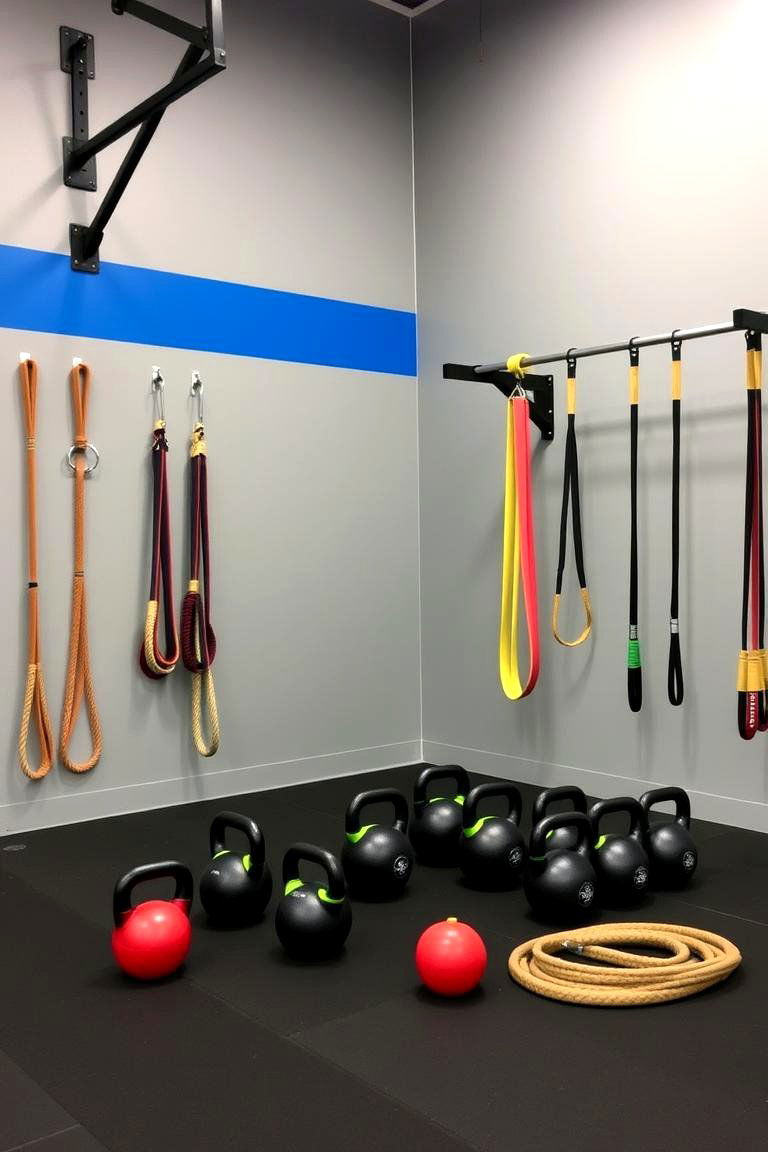
For those interested in functional fitness, creating a dedicated space for strength and conditioning can take your workouts to the next level. Incorporate various equipment, such as kettlebells, battle ropes, medicine balls, and resistance bands, which will allow for a variety of high-intensity workouts. To maximize functionality, opt for a rubberized floor to provide both safety and durability. You can also set up a pull-up bar or a suspension trainer to work on bodyweight exercises. This area will provide everything needed for a full-body conditioning routine.
9. Home Spa and Recovery Zone
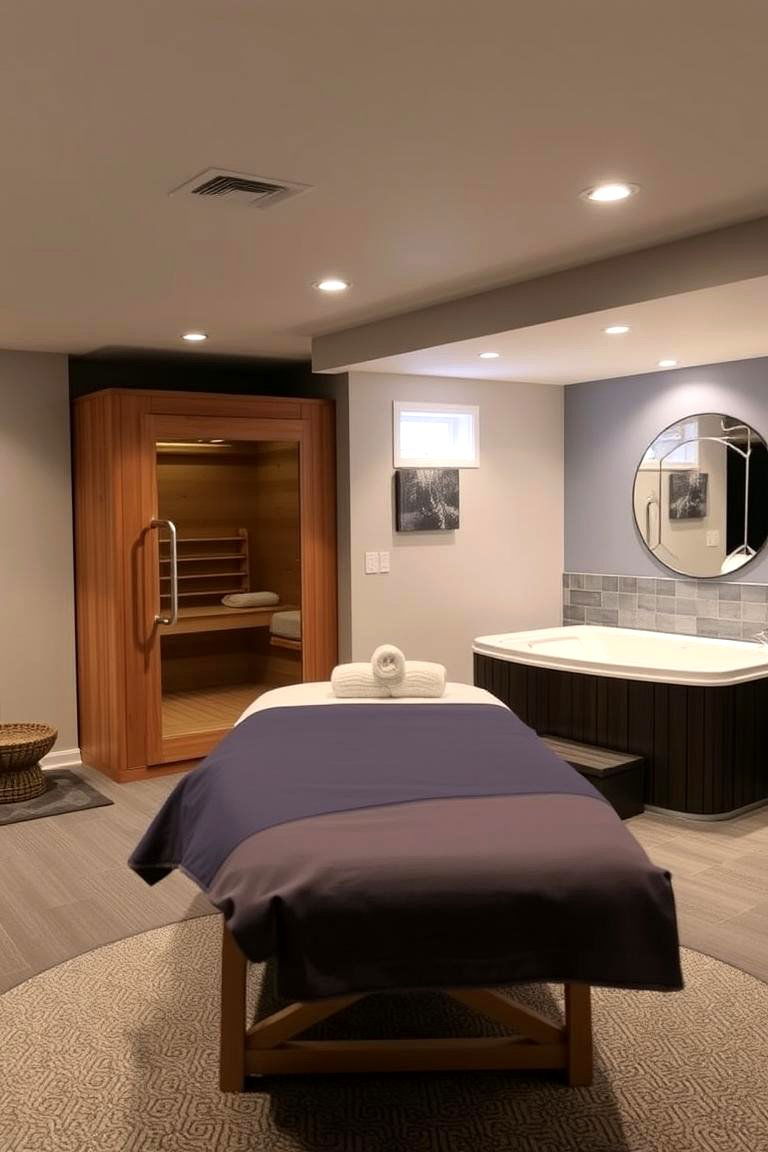
A basement gym doesn’t just need to focus on exercise—it can also be a space for recovery. Set up a home spa area with an infrared sauna, a jacuzzi, or a cold plunge tub to help your muscles recover after intense workouts. Relaxation and muscle recovery are equally important in a fitness routine. Consider incorporating a massage table or massage gun to further promote muscle relief. With the right setup, your basement gym becomes a sanctuary where you can relax and rejuvenate after each workout, ensuring you’re ready for the next session.
10. Customized Home Gym with Tech Integration
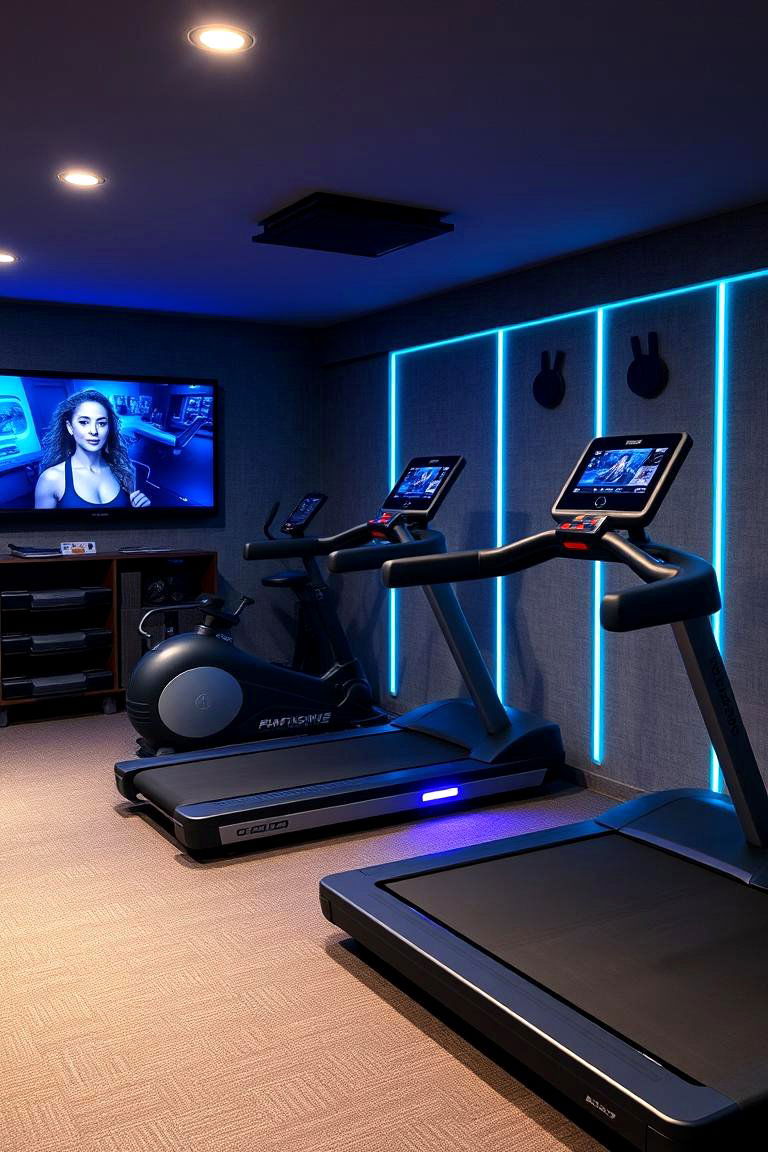
Embrace the future by turning your basement gym into a tech-savvy workout zone. Integrate advanced fitness equipment like smart treadmills, rowing machines, and weights that can track your performance in real time. Adding a large TV or projector for virtual classes and workout tutorials will further elevate the experience. Smart lighting, such as LEDs that change colors based on your workout intensity, can also add a fun, personalized touch. With the right tech setup, your basement gym becomes more than just a place to work out—it becomes an interactive, futuristic fitness hub.
11. Martial Arts Training Space
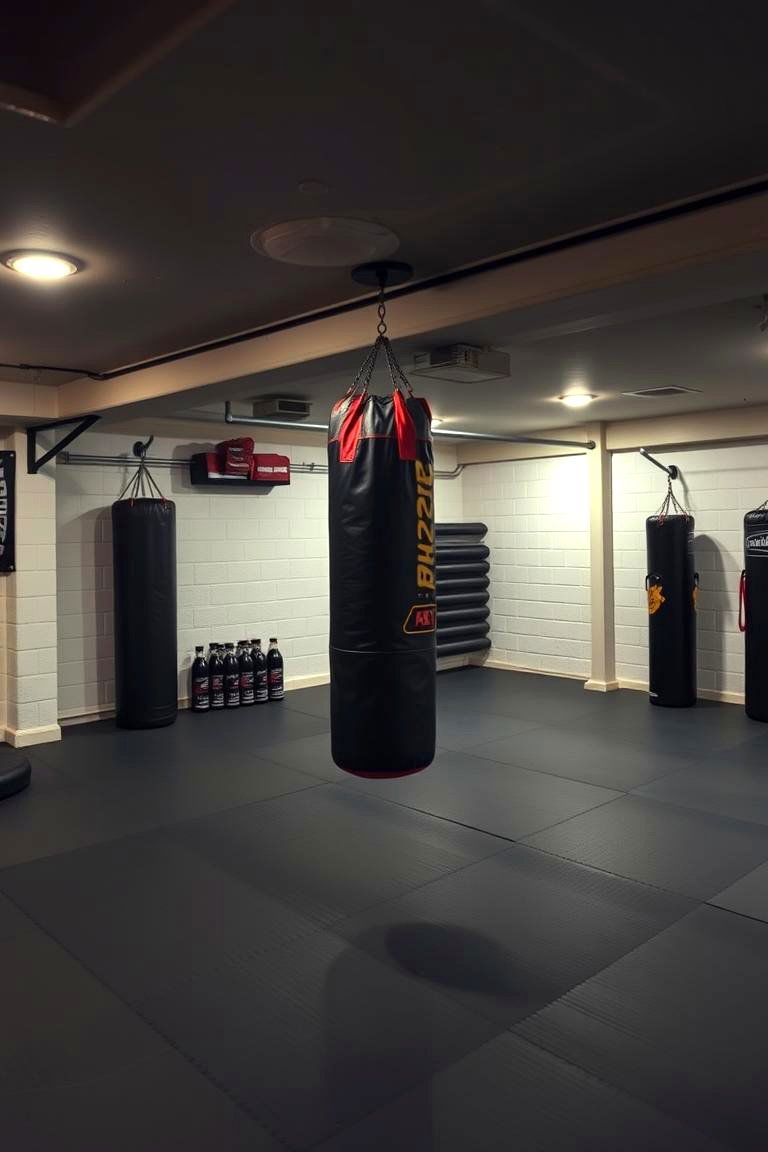
If you’re passionate about martial arts, creating a dedicated training area in your basement can significantly improve your practice. Set up a large punching bag or a speed bag, along with mats for grappling or ground techniques. You can also install mirrors to help with technique and form. Organize the area with shelves to store gloves, pads, and other training equipment. Consider adding a few inspirational posters or a small sound system for motivational music. This specialized setup ensures that your martial arts training is effective, safe, and enjoyable.
12. Functional Circuit Training Area
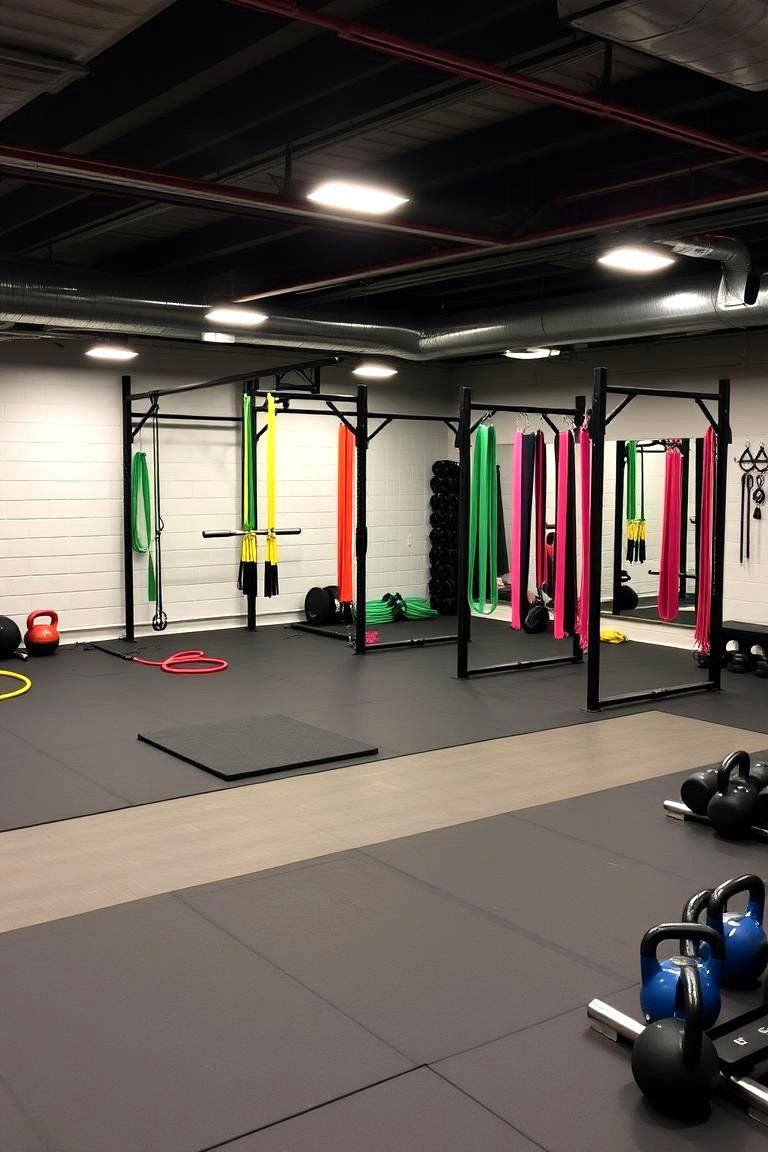
Circuit training combines strength, endurance, and flexibility, and having a dedicated area for it can transform your basement gym. This zone can be filled with various stations, such as resistance bands, free weights, and bodyweight exercises, that you rotate through. You can set up timers and a display screen to track your sets, reps, and rest periods for better control. The floor should be padded to support high-impact activities like jumping or burpees. A dedicated circuit training zone allows for intense, varied workouts that challenge every aspect of your fitness.
13. High-Energy Dance Floor
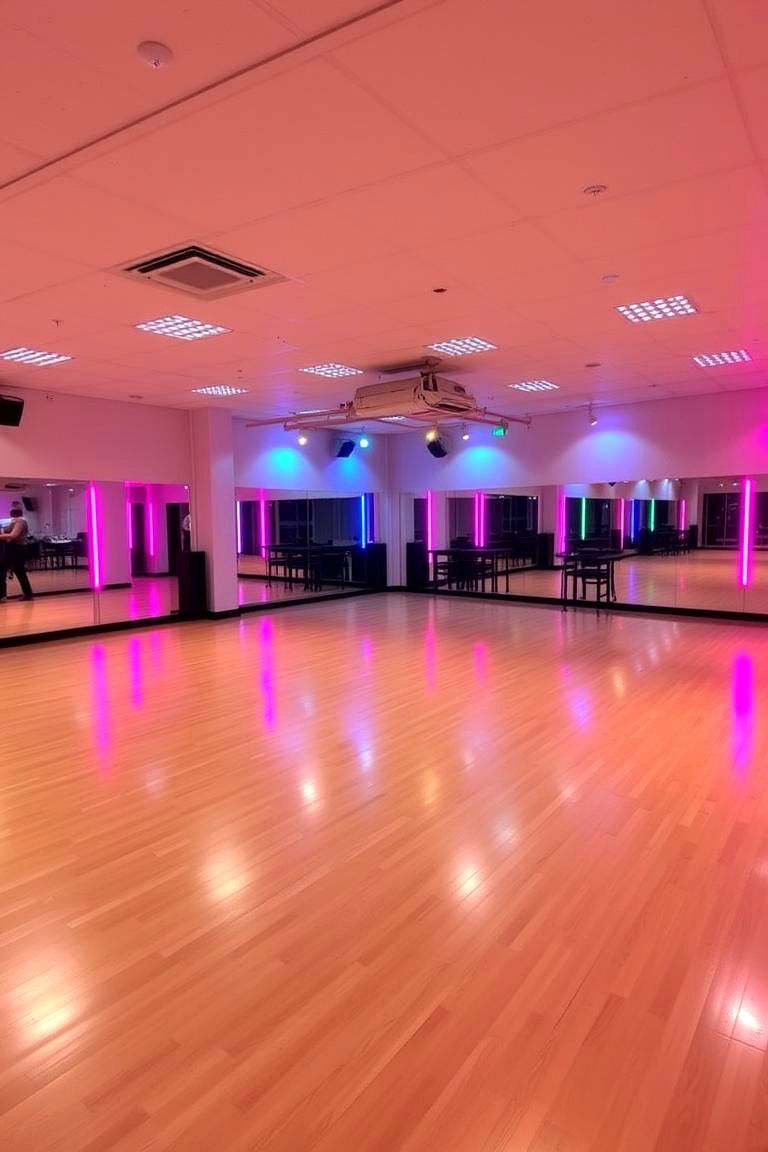
For those who love dancing as a form of exercise, a basement dance floor is a great idea. Install smooth, non-slip flooring and plenty of mirrors for self-checking movements and form. Consider adding LED lights that sync to your beats for a more dynamic atmosphere. Whether you enjoy Zumba, hip-hop, or just a freestyle dance session, this space can offer an energetic and fun way to stay fit. Plus, the added bonus of a good sound system can turn your basement gym into a dance party anytime you need it.
14. CrossFit Gym in Your Basement
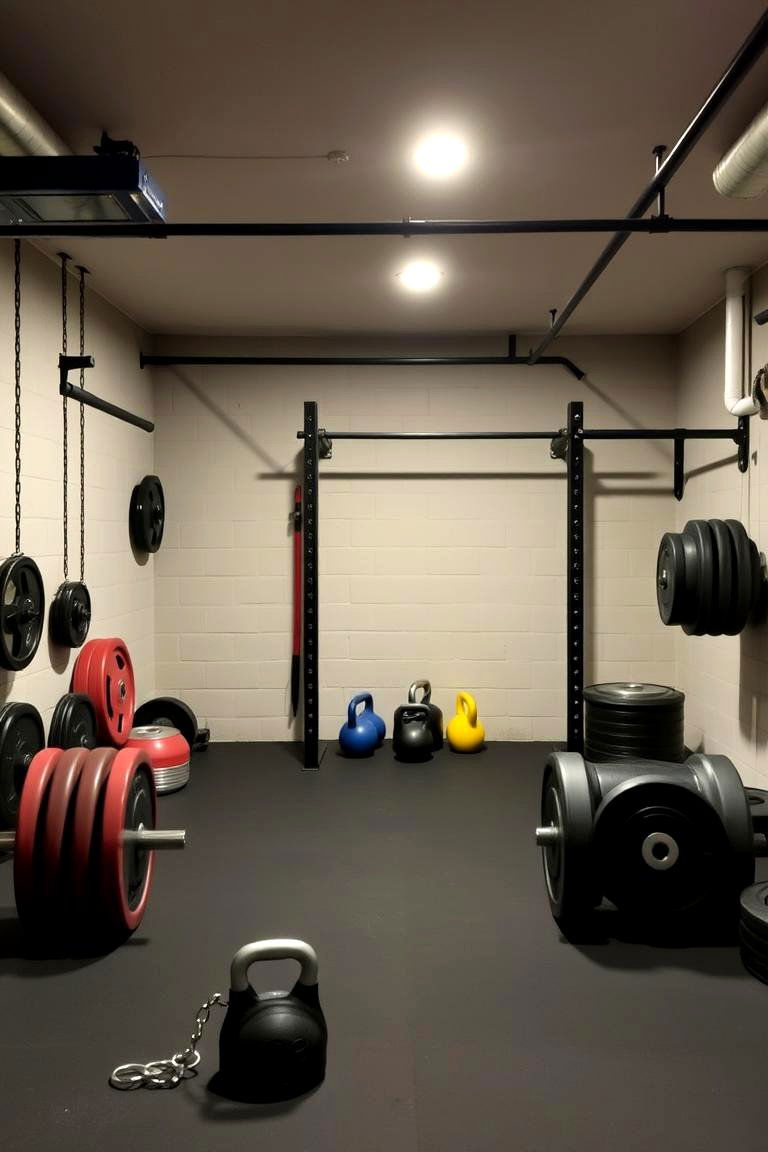
CrossFit enthusiasts can create their ideal training space right in their basement. A CrossFit gym setup requires heavy-duty equipment such as barbells, kettlebells, bumper plates, and a pull-up rig. The space should have enough room for high-intensity, multi-functional movements. High ceilings are beneficial to allow full use of a rope or for overhead lifts. Rubber flooring is a must for durability and noise reduction. Whether you’re performing Olympic lifts, WODs (workout of the day), or other CrossFit exercises, having everything you need in one space makes training more efficient and focused.
15. Home Gym with Full-Body Workout Equipment
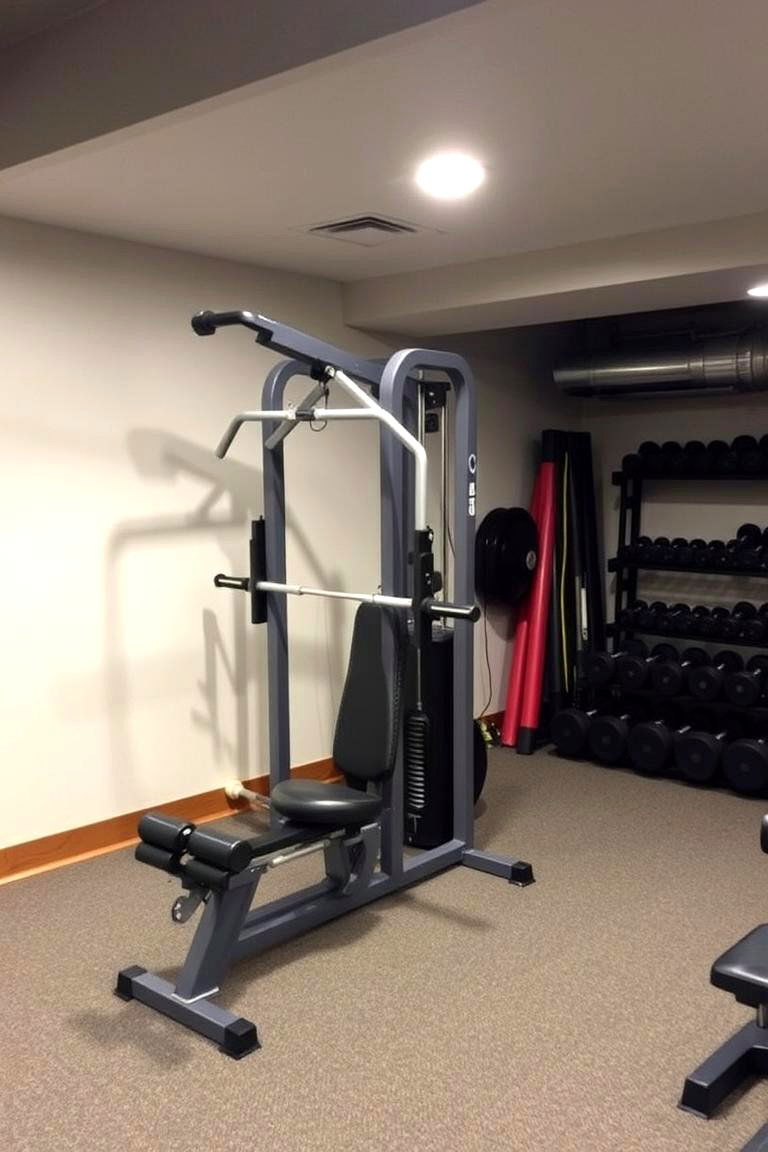
For a comprehensive workout experience, a full-body gym setup is ideal. This setup includes versatile machines that target different muscle groups, such as a rowing machine, leg press, and multi-station weight machine. For a balanced workout, this area can also feature free weights, resistance bands, and dumbbells. The goal is to create a space that enables you to work all muscle groups with minimal equipment, giving you a versatile workout experience. With the right equipment and layout, you’ll be able to target everything from your legs to your core and upper body.
16. Virtual Fitness Room
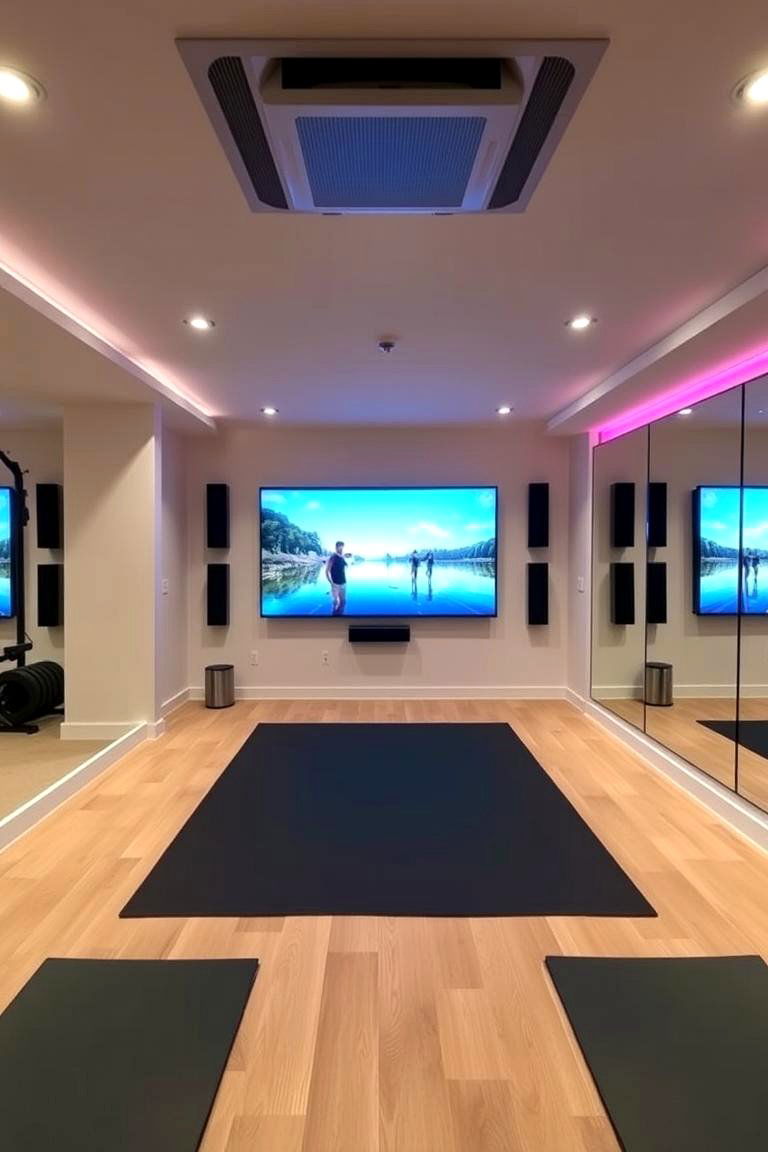
With the rise of online fitness programs, why not create a room dedicated to virtual training in your basement gym? Set up a space with enough room to move freely and place your device where you can clearly see the trainer on screen. Install a large mirror on one wall to check your form, and add a speaker system for the best sound quality. This virtual fitness room enables you to join live workouts, follow training plans, or simply enjoy your own playlist while working out. The convenience of virtual fitness is a major perk for staying active at home.
17. Customized Weight Rack and Storage
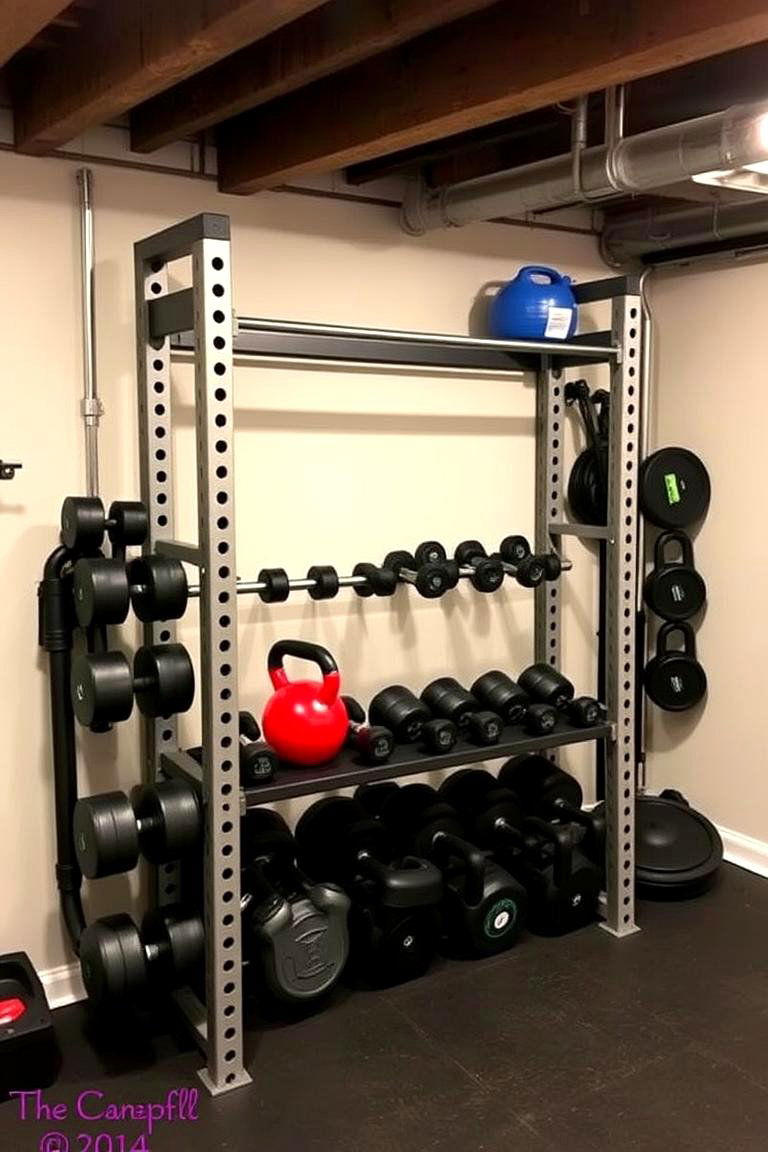
A well-organized basement gym is essential to maintain a functional space. A customized weight rack and storage system help keep equipment neat and easily accessible. Whether you have dumbbells, kettlebells, or barbells, having designated places for each ensures safety and efficiency. Invest in adjustable racks or cabinets that fit your equipment. Additionally, add small baskets or shelving to store smaller items like bands, gloves, and towels. A clean and tidy gym environment promotes motivation and a streamlined workout experience.
18. Home Gym with a Lounge Area
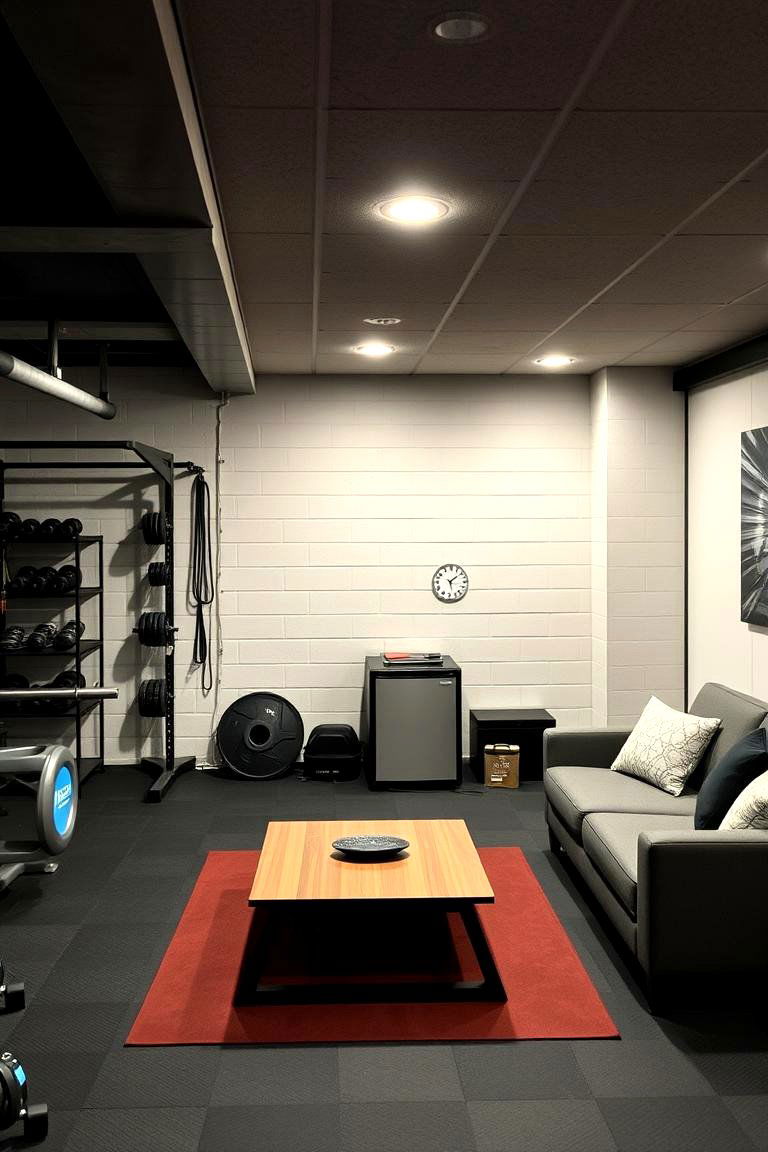
Integrating a lounge area in your basement gym offers a relaxing place to unwind before or after your workout. You can add a comfortable couch or bean bags, a small coffee table, and perhaps even a mini-fridge with post-workout snacks or beverages. This can be a great space for stretching or cooling down with some light reading or music. Having a lounge area also gives the gym a more social vibe, where you can invite friends to join you for a workout or relax afterward. It’s all about creating a space that encourages both exercise and recovery.
19. Basement Gym with Natural Elements
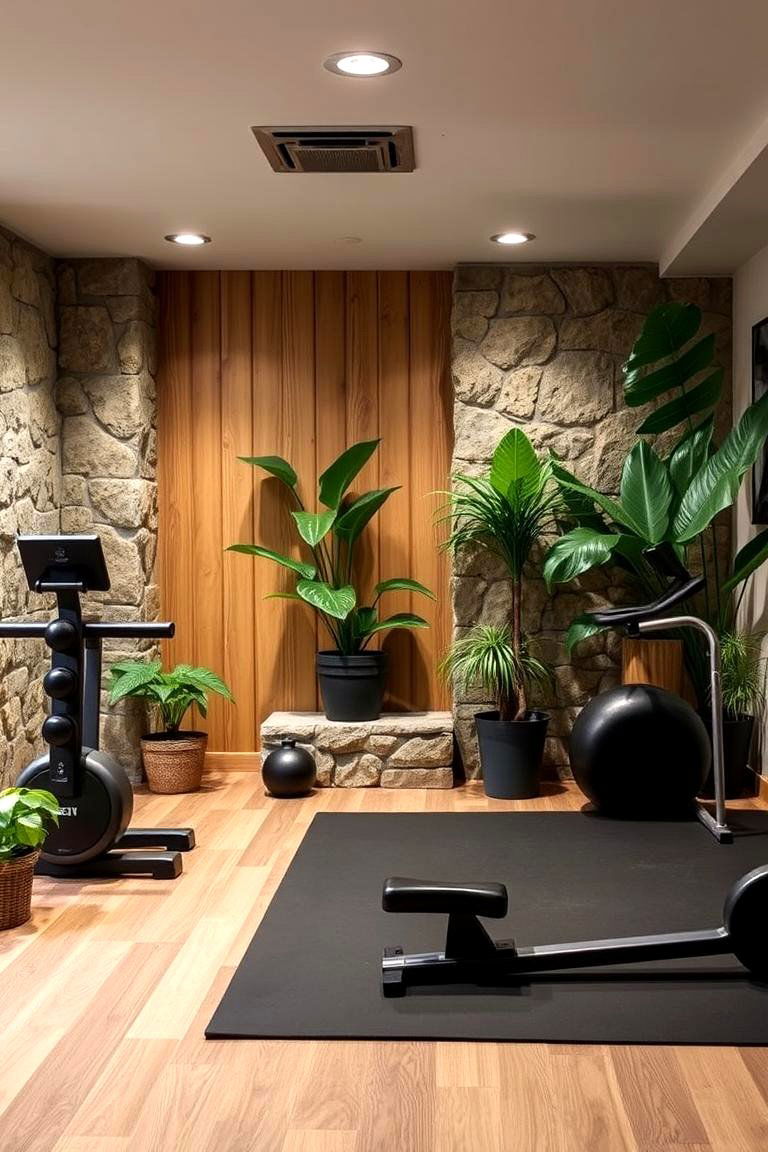
Incorporating natural elements like wood, plants, and stone into your basement gym creates a soothing environment that enhances your workout experience. Wooden flooring or wood-panelled walls bring a warm, organic feel. Adding live plants like ferns, succulents, or even small trees creates a calming atmosphere. Incorporate stone for texture, whether in the flooring or accent walls. These natural materials not only improve the aesthetics of your gym but also help foster a grounded, focused energy that’s ideal for exercising.
20. Functional Bench Press Area
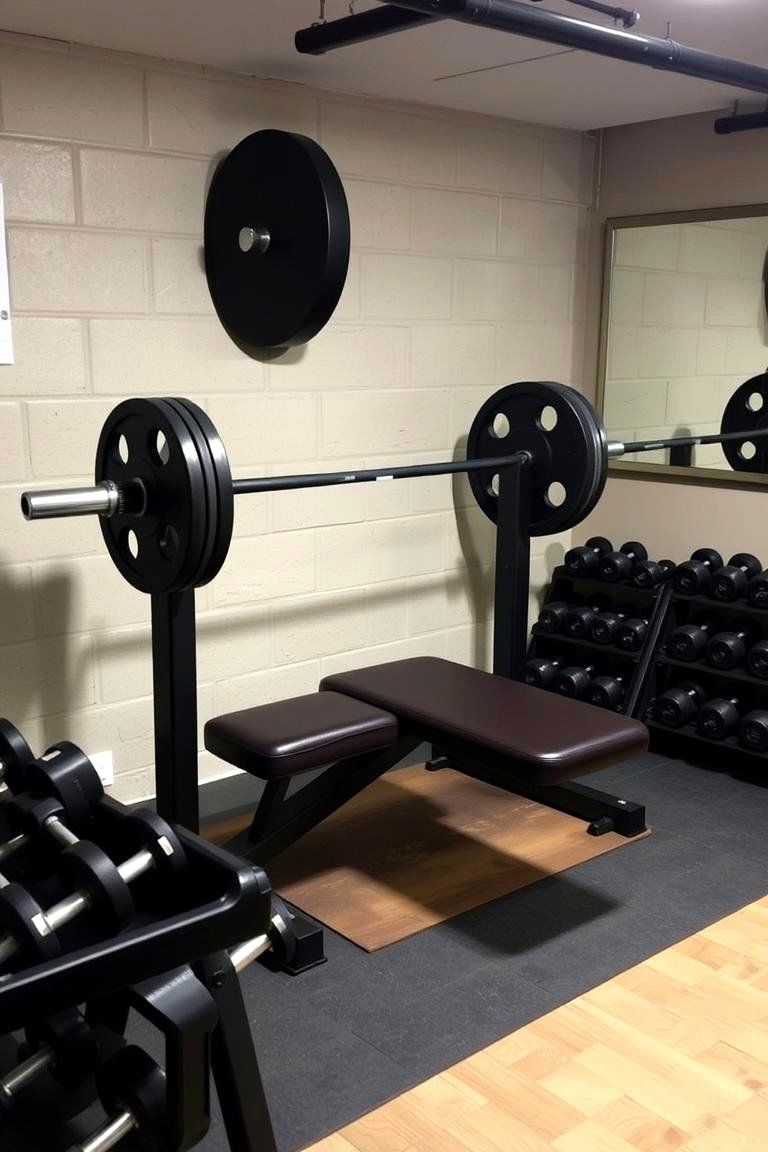
For strength training enthusiasts, having a designated bench press area in your basement gym is essential. The bench press remains one of the most effective exercises for upper body strength. Create a space that includes a sturdy bench, adjustable dumbbells, and an Olympic barbell. If possible, add a mirror to help with your form and positioning. This specialized setup ensures that you can perform this key exercise safely and efficiently. Additionally, the area should be spacious enough to accommodate different exercises, including presses and fly movements.
21. Basement Gym with Sauna and Steam Room
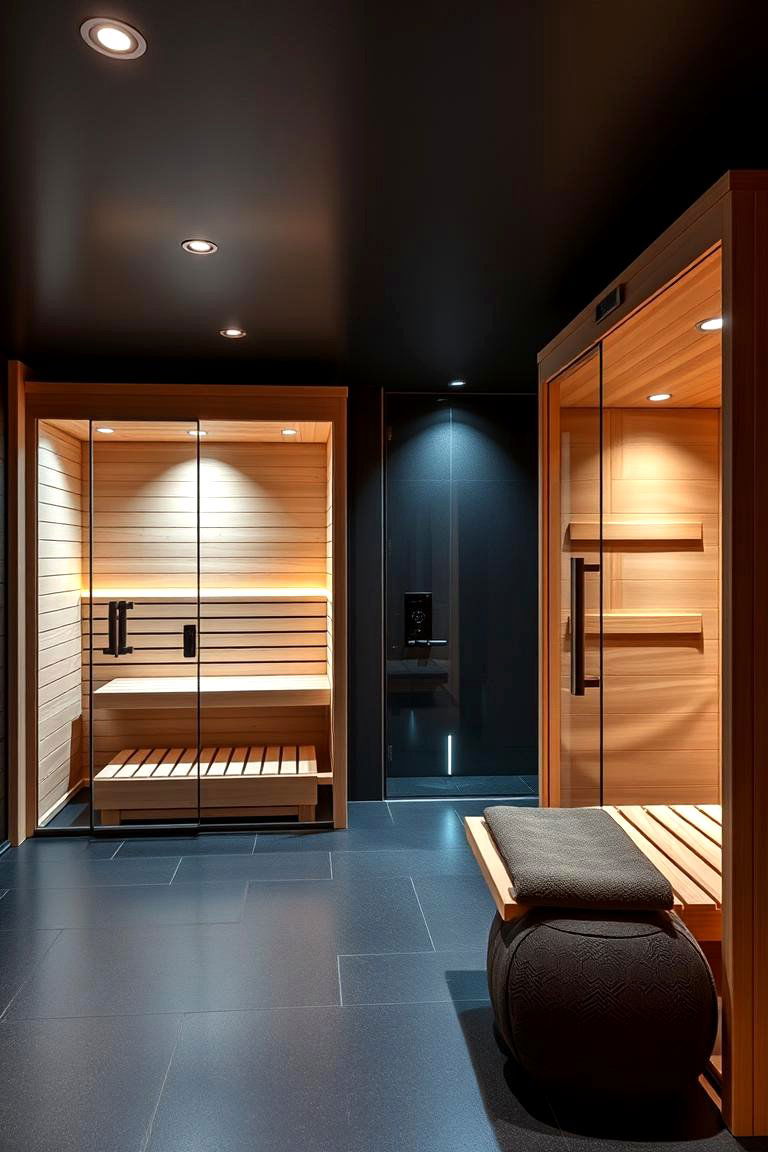
For the ultimate fitness experience, consider adding a sauna or steam room to your basement gym. Not only do these features help with muscle relaxation and recovery, but they also provide health benefits such as improved circulation and detoxification. After an intense workout, stepping into a sauna or steam room can accelerate recovery, reduce muscle soreness, and provide mental relaxation. This space will elevate your home gym into a wellness retreat where you can focus on both fitness and self-care.
22. Resistance Training Room
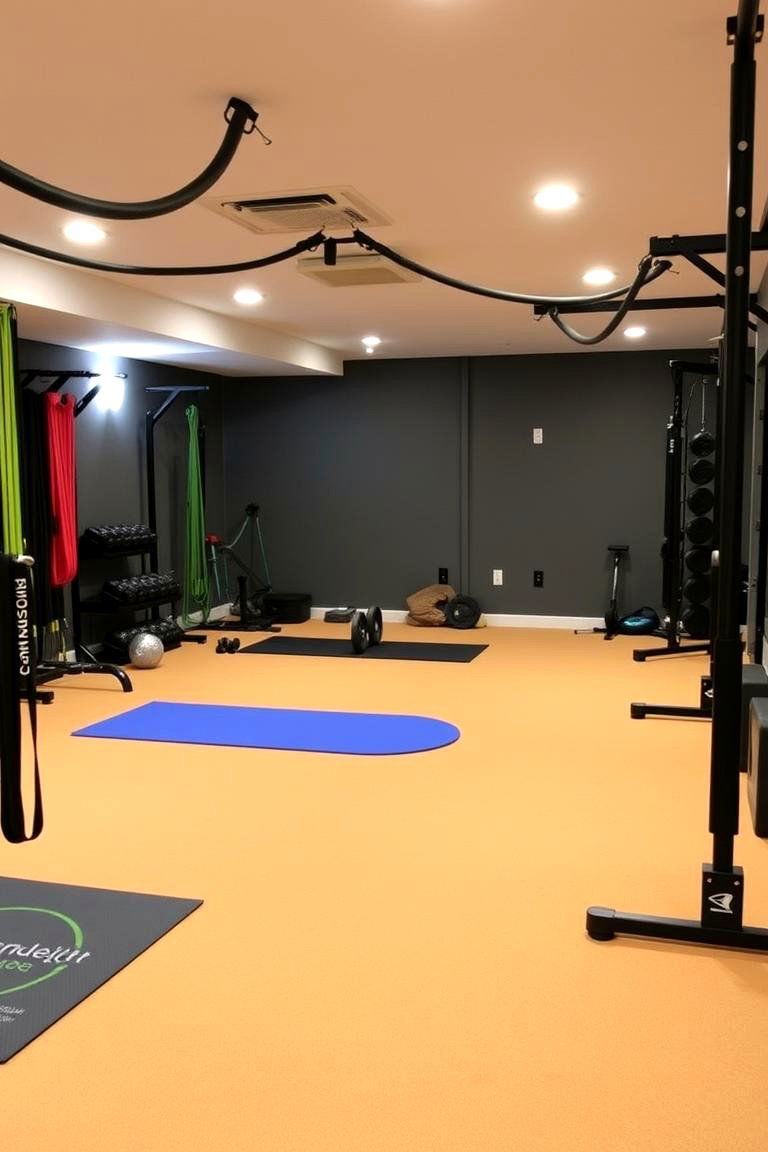
Resistance training is a cornerstone of any effective fitness program, and having a dedicated space for it in your basement gym makes a significant difference. Incorporate a variety of resistance equipment such as bands, cables, and free weights. These tools help increase strength, flexibility, and endurance. You can also create a space for bodyweight exercises like push-ups, squats, and lunges. Adding a mirror to check your form will keep your workouts safe and effective. A resistance training room will help you build lean muscle and increase overall fitness.
23. Sports Performance Area
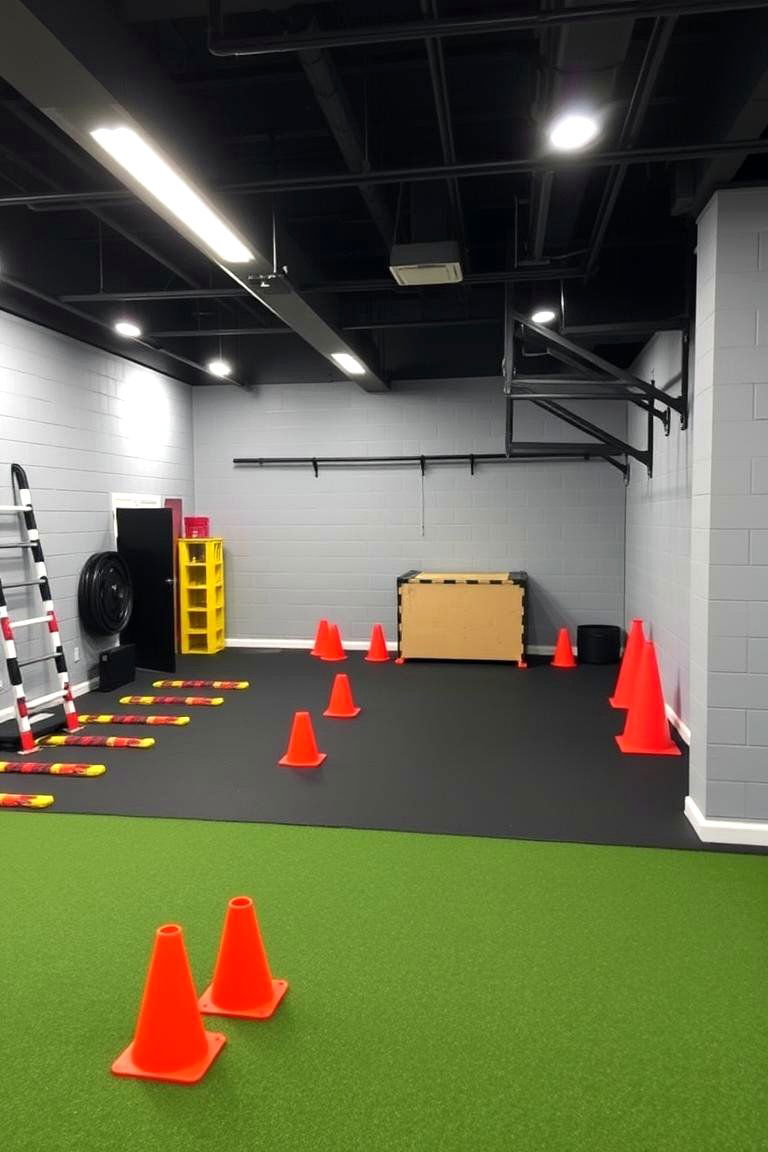
Elevating your sports performance often requires specialized training. Dedicate a portion of your basement gym to improving agility, speed, and strength with tools such as agility ladders, cones, and speed ropes. A plyometric box for box jumps or a sled for sprinting can also be added for more explosive movements. This setup is ideal for athletes looking to boost their performance in sports like soccer, basketball, or track and field. With the right equipment and design, you can improve key performance metrics in a fun, high-energy environment.
24. Minimalist Gym Design
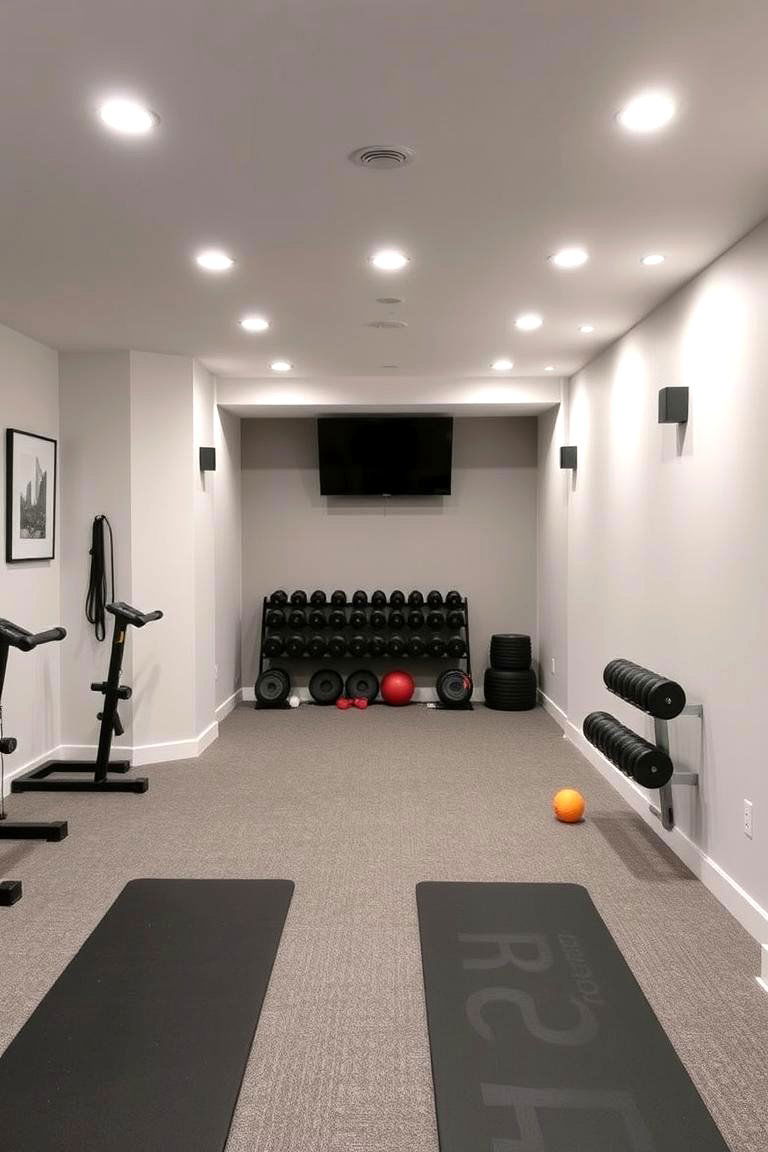
Sometimes, less is more. A minimalist gym design can be sleek, modern, and highly effective. Focus on the essentials, such as free weights, resistance bands, and bodyweight exercises, to create an uncluttered, functional space. Use clean lines, neutral colors, and simple decor to avoid distractions and keep the focus on your fitness goals. This approach works well for small basements, where maximizing space and maintaining a calm atmosphere are priorities. The minimalist design helps you stay organized, motivated, and clear-headed during your workouts.
Conclusion:
Your basement gym offers unlimited potential for creating a personalized workout sanctuary that motivates and supports your fitness journey. Whether you're looking to incorporate sleek designs, functional equipment, or a mix of both, there’s an idea that fits your space and style. A well-designed basement gym not only enhances your workouts but also adds significant value to your home. Make the most of your basement's potential and start building your dream gym today!


